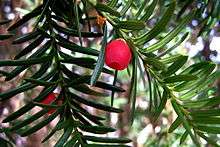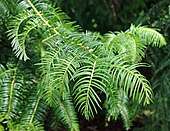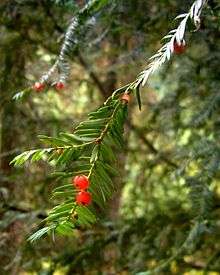Taxaceae
Taxaceae (/tækˈseɪsii/), commonly called the yew family, is a coniferous family which includes six extant and two extinct genera, and about 30 species of plants, or in older interpretations three genera and 7 to 12 species.
| Taxaceae | |
|---|---|
 | |
| Foliage and mature arils of a yew plant | |
| Scientific classification | |
| Kingdom: | Plantae |
| Clade: | Tracheophytes |
| Division: | Pinophyta |
| Class: | Pinopsida |
| Order: | Pinales |
| Family: | Taxaceae S.F.Gray |
| Genera | |
| Synonyms | |
| |
They are many-branched, small trees and shrubs. The leaves are evergreen, spirally arranged, often twisted at the base to appear 2-ranked. They are linear to lanceolate, and have pale green or white stomatal bands on the undersides. The plants are dioecious, rarely monoecious. The male cones are 2–5 millimetres (0.079–0.197 in) long, and shed pollen in the early spring. The female 'cones' are highly reduced to a single seed. As the seed matures, a fleshy aril partly encloses it. The developmental origin of the aril is unclear, but it may represent a fused pair of swollen leaves.[1] The mature aril is brightly coloured, soft, juicy and sweet, and is eaten by birds which then disperse the hard seed undamaged in their droppings. However, the seeds are highly poisonous to humans, containing the poisons taxine and taxol.[2]
Classification
Taxaceae is now generally included with all other conifers in the order Pinales, as DNA analysis has shown that the yews are phylogenetically nested in the Pinales [3], a conclusion supported by micromorphology studies [4]. Formerly they were often treated as distinct from other conifers by placing them in a separate order Taxales. Ernest Henry Wilson referred to Taxaceae as "taxads" in his 1916 book.[5]
The broadly defined Taxaceae (including Cephalotaxus) comprises six extant genera and about 30 species overall. Cephalotaxus is now included in Taxaceae, rather than being recognized as the core of its own family, Cephalotaxaceae. Phylogenetic evidence strongly supports a very close relationship between Cephalotaxus and other members of Taxaceae[6],[7],[8], and morphological differences between them are not substantial. Previous recognition of two distinct families, Taxaceae and Cephalotaxaceae (e.g., [9]), was based on relatively minor morphological details: Taxaceae (excluding Cephalotaxus) has smaller mature seeds growing to 5–8 millimetres (0.20–0.31 in) in 6–8 months, that are not fully enclosed by the aril; in contrast, Cephalotaxus seeds have a longer maturation period (from 18–20 months), and larger mature seeds (12–40 millimetres (0.47–1.57 in)) fully enclosed by the aril. However, there are also very clear morphological connections between Cephalotaxus and other members of Taxaceae [10],[11], and considered in tandem with the phylogenetic evidence, there is no compelling need to recognize Cephalotaxus (or other genera in Taxaceae) as a distinct family[6],[7].
Extant genera
| Genus | Species | Image |
|---|---|---|
|
Amentotaxus Pilg. – Catkin-yew |
|
|
|
Austrotaxus Compton – New Caledonia yew |
|
Austrotaxus spicata |
|
Cephalotaxus Siebold & Zucc. ex Endl. – Plum yew |
|
|
|
Pseudotaxus W.C.Cheng – White-berry yew |
|
|
|
Taxus L. – Common yew |
|
|
|
Torreya Arn. – Nutmeg yew |
|
|
Footnotes
| Wikimedia Commons has media related to Taxaceae. |
| Wikispecies has information related to Taxaceae |
- Dörken, Veit Martin; Nimsch, Hubertus; Rudall, Paula J (2018-08-22). "Origin of the Taxaceae aril: evolutionary implications of seed-cone teratologies in Pseudotaxus chienii". Annals of Botany. Oxford University Press (OUP). 123 (1): 133–143. doi:10.1093/aob/mcy150. ISSN 0305-7364. PMC 6344100. PMID 30137225.
- Yew Poisoning: MedLine Plus Medical Encyclopedia
- Chase, M. W.; Soltis, D. E.; et al. (1993). "Phylogenetics of Seed Plants: An Analysis of Nucleotide Sequences from the Plastid Gene rbcL" (PDF). Annals of the Missouri Botanical Garden. JSTOR. 80 (3): 528. doi:10.2307/2399846. ISSN 0026-6493. JSTOR 2399846.
- Anderson, E.; Owens, J.N. (2003). "Analyzing the Reproductive Biology of Taxus: Should It be Included in Coniferales?". Acta Horticulturae. International Society for Horticultural Science (ISHS) (615): 233–234. doi:10.17660/actahortic.2003.615.22. ISSN 0567-7572.
- Wilson, Ernest Henry (1916). The conifers and taxads of Japan. Issued December 30, 1916. Cambridge: University Press. doi:10.5962/bhl.title.17457.
- Quinn, C. J.; Price, R. A.; Gadek, P. A. (2002). "Familial Concepts and Relationships in the Conifer Based on rbcL and matK Sequence Comparisons". Kew Bulletin. JSTOR. 57 (3): 513. doi:10.2307/4110984. ISSN 0075-5974. JSTOR 4110984.
- Rai, Hardeep S.; Reeves, Patrick A.; Peakall, Rod; Olmstead, Richard G.; Graham, Sean W. (2008). "Inference of higher-order conifer relationships from a multi-locus plastid data set". Botany. Canadian Science Publishing. 86 (7): 658–669. doi:10.1139/b08-062. ISSN 1916-2790.
- One Thousand Plant Transcriptomes Initiative (2019). "One thousand plant transcriptomes and the phylogenomics of green plants". Nature. Springer Science and Business Media LLC. 574 (7780): 679–685. doi:10.1038/s41586-019-1693-2. ISSN 0028-0836. PMC 6872490. PMID 31645766.
- Hart, Jeffrey A. (1987). "A Cladistic Analysis of Conifers: Preliminary Results". Journal of the Arnold Arboretum. 68 (3): 269–307. JSTOR 43782212.
- Doyle, James A. (1998). "Phylogeny of Vascular Plants". Annual Review of Ecology and Systematics. Annual Reviews. 29 (1): 567–599. doi:10.1146/annurev.ecolsys.29.1.567. ISSN 0066-4162.
- Stützel, Thomas; Röwekamp, Iris (1999). "Female reproductive structures in Taxales". Flora. Elsevier BV. 194 (2): 145–157. doi:10.1016/s0367-2530(17)30893-9. ISSN 0367-2530.
- Manchester, S.R. (1994). "Fruits and Seeds of the Middle Eocene Nut Beds Flora, Clarno Formation, Oregon". Palaeontographica Americana. 58: 30–31.


.jpg)